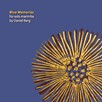
Stella Polaris
Composer: Daniel Berg
Instrument: Vibraphone
Level: Easy
Published: 2010
Price: €16.00
Item details
-
Description +
-
Duration: 15 min.
This booklet is addressed primary to students who are beginning to learn the basic Vibraphone techniques. Each song focus on something that is characteristic for the vibraphone - e.g. dampening, pedaling.
My wish is that these songs will create a continues interest for the Vibraphone and create a bridge to the other solo and chamber music literature for this instrument.
Stella Polaris (also called the North or Pole Star), is the brightest star in the constellation Ursa Minor and located at a distance of approximately 430 light years from Earth. Polaris shows the north direction by its location only one degree from the north celestial pole.
-
-
Instrumentation +
-
Vibraphone
-
-
Watch+
-
About the composer +
-
Daniel Berg is a Swedish composer, musician, and professor in classical percussion at the Royal College of Music in Stockholm and at the Academy of music and drama in Gothenburg.
In his passion to promote the marimba as a solo- and chamber music instrument, Daniel has worked intimately with a number of composers who have written original music for the instrument. This includes more than 300 world premier for solo and chamber works. Daniel Berg is a marimba artist of Bergerault and Elite Mallets.
As a composer Daniel has written a lot for solo marimba like Mistral (for Michael Burritt), Phoenix (for Robert van Sice) and Yán Jiâng (for the Taiwan World Percussion Competition). His music for percussion ensemble have been appreciated and often performed like Kroumata (for sextet) and Arctic Nights (for quintet) - all published by Edition Svitzer.
-
-
Reviews +
-
Review (Percussive Notes, March (58) 2012)
This collection of five short solos is perfect for introducing playing styles and character of upper level vibraphone literature to students that might not be ready to tackle the length and overall difficulty level typically associated with such works. Each solo, which ranges from one to three minutes, focuses on one element of vibraphone performance such as pedaling, dampening, interlocking rhythms, etc. Akin to marimba books of the same vein, such as Quartier’s Image collection, the music is written in a style that serves as a springboard to popular classical vibraphone literature.
Amongst the solos, melodic and harmonic variety is found in the form of steady eighth-note lines, interlocking groovy sixteenth-note passages, and one solo completely void of time and tempo constraints. Berg offers limited explanation on performing these works; however, the simplicity of the music makes performance success achievable. Students and teachers alike will appreciate the depth and accessibility of the music from this accomplished composer. —Joshua D. Smith
-
-
Credits +
-
Front Cover graphics and layout: Ronni Kot Wenzell
Enamel painting: Bengt Berglund
Engraving: Johan Svitzer
Printed in Copenhagen, Denmark
Copyright © Edition SVITZER
www.editionsvitzer.com
-





